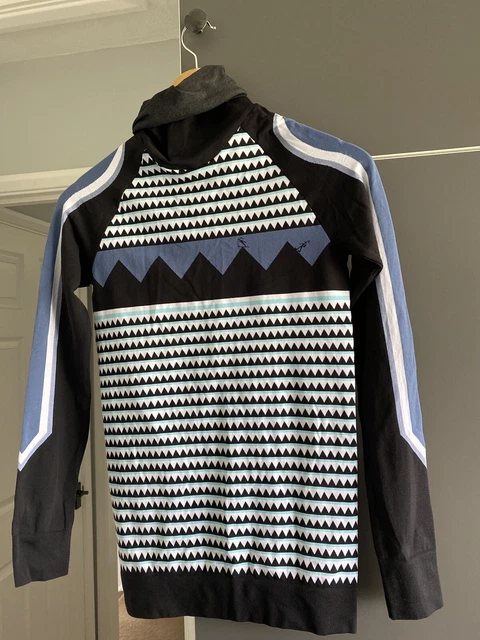Both Merino wool and yak wool have natural temperature-regulating properties due to the unique characteristics of their fibers. These properties allow them to keep the body's temperature in a healthy way by adjusting the surrounding. This is the way Merino wool and yak wool are able to achieve the natural regulation of temperature.
Merino Wool
Merino fibers are naturally wavy or crimped, creating air pockets within fabric. These pockets act as insulation, storing heat close to the skin in frigid temperatures and supplying thermal insulation.
Moisture Management- Merino wool has the ability to absorb moisture from the body and release it into the air around it. The "wicking" process is what we call it. This process is referred to as "wicking."
Merino fibres provide good airflow. This helps to prevent overheating since it lets excess heat go away, ensuring an optimum temperature.
Merino wool is both hydrophilic, (water-attracting) as well as hydrophobic. The dual nature of the wool makes it a great choice for managing moisture and controlling humidity.
Yak Wool
Hollow Fibers- Yak wool fibers are naturally hollow, creating air pockets inside the material. They provide great insulation by trapping warm air near the body.
The insulation properties of Yak wool has an unique structure that holds air and are therefore perfect in colder climates. The hollow core provides the fibers an additional layer to add insulation.
Moisture Wicking Yak wool can be used to wick water off your skin. This will help you remain dry and comfortable throughout exercise.
Temperature Regulating- The insulation of yaks wool regulates the body's temperature by stopping the loss of heat during frigid conditions. The fibers help maintain an environment that is warm near to the skin.
Both Merino wool and yak wool's temperature-regulating properties are a result of their natural structure, which creates a balance between warmth, moisture management, and breathability. The fibers are ideal for clothing in all types of weather conditions. The ability to adapt to the changing temperatures will keep you in good shape during outdoor activities as well as throughout the day. Follow the recommended skiing base layers examples for site info including layering pants for skiing, buy ski thermals, betty ski base layer, ski thermal top womens, spyder base layer pants, slalom base layer, ski jacquard half zip ski base layer top, best ski base layer women's, x bionic ski base layer, men's ski base layer pants, and more.

How Does The Base Layering System Allow You To Adjust The Ski Clothes According To Your Activity And Weather?
Base layers are designed to offer flexibility and aptitude to your clothing depending on the level of activity and weather conditions. They are comprised of several layers, each with a specific function. They all work together to ensure that the wearer is comfortable and safe when engaging in outdoors activities, like skiing. You can alter your ski clothes by using layers of base.
Base Layer
The first layer you see. It is responsible for moisture regulation as well as the regulation of temperature.
In frigid temperatures the base layer constructed from materials such as Merino or yak fibers will help move sweat out and keep you warm.
As temperatures rise or your level of activity rises, a breathable outer layer allows heat to escape.
Mid Layer
The midlayer is responsible for the insulation as well as warmth. The middle layer assists in retain body heat, and creates a barrier from cold air.
You can adjust the warmth of your clothing by removing or adding an outer layer, based on the conditions. For colder temperatures, you should choose a mid layer that is more thick. In milder temperatures you might want to select one that is thinner or not wear anything at all.
Outer Layer (Shell-
The outer layer, also called the shell, serves as a shield against rain, wind, and snow.
You can safeguard yourself from the elements if the weather is tough and heavy.
If the weather is warm it is possible to select a light shell that provides wind resistance but not excessive insulation.
Adjustability-
The flexibility to adjust is one of the advantages of layering on the base. It is easy to remove or add layers when your schedule changes or the weather changes.
You can, for instance wear layers if you get up in the morning cold and then set out for skiing downhill. You can remove your mid-layer as you begin to warm up following the activity.
Versatility-
These systems can be adapted to a variety of outdoor activities, not just skiing. Follow the same rules when you are skiing, hiking, or climbing mountains.
Comfort and Performance
By altering layering, you are able to keep a cool, comfortable body temperature and avoid overheating.
This degree of temperature control improves your overall performance, and allows you to focus on enjoying your sport.
Think about the fact that success when layering your base layers relies on knowing the right materials to apply to each and understanding the needs of your body and the weather conditions you will face. Making sure you invest in high-quality base, middle and outer layers that are designed to meet the particular requirements of skiing and other outdoor activities is crucial. View the top merino wool thermals hints for website examples including women's merino 200 oasis long sleeve half zip thermal top, icebreaker baselayer, intraknit merino 250, smart wool baselayer, best merino base layer skiing, best merino wool base layer for stand hunting, ripzone merino baselayer, kari traa baselayer merino wool, smartwool 1 4 zip mens, wool thermals womens, and more.




